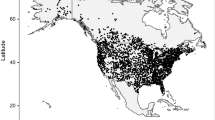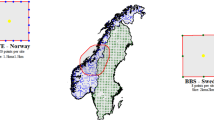Abstract
This study investigated methods for identifying daily incidence rates for bird species. It focused on relationships between incidence rates, site and season. We used sightings of 23 common resident species routinely reported every month from January 2004 to December 2007 at seven wetland locations in the Thale Noi non-hunting area of southern Thailand. Our findings revealed that the log-linear model gives a quite satisfactory fit, so it appears a suitable type of model for bird abundance. On taking logarithms of the incidence rates though, the zero counts must be replaced by an appropriate constant. Our model suggests that Cattle Egret (Bubulcus ibis) was found at the Thale Noi non-hunting area with the highest incidence rate. In contrast, we found a low mean of model outputs for Lesser Whistling-Duck (Dendrocygna javanica) relative to the mean in the data, and this species was not observed on at least 25 % or 3 days per year. These data had a low number of zeros and a large number of various species. Therefore, we recognize a remark on “what is being counted” that it is important to reasonably explain the species abundance in terms of statistical and ecological approaches.





Similar content being viewed by others
References
Aratrakorn, S., Thunhikorn, S., & Donald, F. P. (2006). Change in bird communities following conversion of lowland forest to oil palm and rubber plantations in southern Thailand. Bird Conservation International, 16(1), 71–82.
Austin, M. P. (2002). Spatial prediction of species distribution: An interface between ecological theory and statistical modeling. Ecological Modelling, 157, 101–118.
Austin, M. P. (2007). Species distribution models and ecological theory: A critical assessment and some possible new approaches. Ecological Modelling, 200, 1–19.
Bradbury, R. B., Kyrkos, A., Morris, A. J., Clark, S. C., Perkin, A. J., & Wilson, J. D. (2000). Habitat associations and breeding success of yellowhammer on lowland farmland. Journal of Applied Ecology, 37, 789–805.
Clark, K. R., & Warwick, R. M. (1994). A textbook of change in marine communities: An approach to statistical analysis and interpretation (1st ed.). Plymouth: Plymouth Marine Laboratory.
Fasola, M., & Ruiz, X. (1996). The value of rice fields as substitutes for natural wetlands for waterbirds in the mediterranean region. Colonial Waterbirds, 19(Special Publication 1), 122–128.
Gates, S., & Donald, P. F. (2000). Local extinction of British farmland birds and the prediction of further loss. Journal of Applied Ecology, 37, 806–820.
Gibson, L. A., Wilson, B. A., Cahill, D. M., & Hill, J. (2004). Spatial prediction of rufous britlebird habitat in a coastal heathland: A GIS-based approach. Journal of Applied Ecology, 41, 213–223.
Grassle, J. F., & Maciolek, N. J. (1992). Deep-sea species richness: Regional and local diversity estimates from quantitative bottom samples. The American Naturalist, 139, 313–341.
Greene, W. H. (2008). Functional forms for the negative binomial model for count data. Economics Letters, 99, 585–590.
Guisan, A., Edwards, T. C., & Hastie, T. (2002). Generalized linear and generalized additive models in studies of species distributions: Setting the scene. Ecological Modelling, 157, 89–100.
Hamer, T. L., Flather, C. H., & Noon, B. R. (2006). Factors associated with grassland bird species richness: The relative roles of grassland area, landscape structure, and prey. Landscape Ecology, 21(4), 569–583.
Hosmer, D. W, Jr, & Lemeshow, S. (2000). Applied logistic regression. New York: Wiley.
Johnston, A., Fink, D., Reynolds, M. D., Hochachka, W. M., Sullivan, B. L., Bruns, N. E., et al. (2015). Abundance models improve spatial and temporal prioritization of conservation resources. Ecological Applications, 25(7), 1749–1756.
Kaewdee, W., Thirakhupt, K., & Tunhikorn, S. (2002). Population of waterbirds in the breeding colony at Khuan Khi Sian, Thailand’s First Ramsar Site. The Natural History Journal of Chulalongkorn University, 2, 51–58.
Kongchouy, N., Choonpradub, C., & Kuning, M. (2010). Methods for modeling incidence rates with application to pneumonia among children in Surat Thani province, Thailand. Chiang Mai Journal of Science, 37, 29–38.
Lekagul, B., & Round, P. D. (2005). A guide to the birds of Thailand. Bangkok: Saha Karn Bhaet Group.
Madon, B., Warton, D. I., & Araújo, M. B. (2013). Community-level vs species-specific approaches to model selection. Ecography, 36, 1291–1298.
Manel, S., Buckton, S. T., & Ormerod, S. J. (2000). Testing large scale hypotheses using surveys: The effects of land use on the habitats, invertebrates and birds of Himalayan rivers. Journal of Applied Ecology, 37, 756–770.
May, R. M. (1988). How many species are there on earth? Science, 241, 1441–1449.
Milsom, T. P., Langton, S. D., Parkin, W. K., Peel, S., Bishop, J. D., Hart, J. D., et al. (2000). Habitat models of bird species’ distribution: An aid to the management of coastal grazing marshes. Journal of Applied Ecology, 37, 706–727.
Mora, C., Tittensor, D. P., Adl, S., Simpson, A. G. B., & Worm, B. (2011). How many species are there on earth and in the ocean? PLoS Biology, 9, 1–7.
Nguyen, P. B. H., Nguyen, V. H., Doan, V. N., Nguyen, H. M. H., Nguyen, N. T., Pham, Q. D., et al. (2009). Grassland birds survey and correlations between grassland birds and their habitat variables in Tram Chim National Park. Report for the Rufford small grants for nature conservation (pp. 6–8).
Osborn, P. E., Alonso, J. C., & Bryant, R. G. (2001). Modelling landscape-scale habitat use using GIS and remote sensing: A case study with great bustards. Journal of Applied Ecology, 38, 458–471.
Potts, J. M., & Elith, J. (2006). Comparing species abundance models. Ecological Modelling, 199, 153–163.
Raven, P. H. (1985). Disappearing species: A global tragedy. Futurist, 19, 8–14.
Ridout, M., Demetrio, C., & Hinde, J. (1998). Models for count data with many zeros. International biometric conference, Cape Town (pp. 1–13).
Rittiboon, K., & Karntanut, W. (2011). Distribution of resident birds in a protected tropical habitat in south Thailand. Journal of International Society for Southeast Asian Agricultural Sciences, 17(2), 95–103.
Rittiboon, K., Tongkumchum, P., & Karntanut, W. (2012). Bird assemblages in the Thale Noi non-hunting area, southern Thailand. Journal of Sustainability Science and Management, 7, 42–48.
Rushton, S. P., Ormerod, S. J., & Kerby, G. (2004). New paradigms for modeling species distributions? Journal of Applied Ecology, 41, 193–200.
Schrag, A. M., Zaccagnini, M. E., Calamari, N., & Canavelli, S. (2009). Climate and land-use influences on avifauna in central Argentina: Broad-scale patterns and implications of agricultural conversion for biodiversity. Agriculture, Ecosystems & Environment, 132(1/2), 135–142.
Segan, D. B., Bottrill, M. C., Baxter, P. W. J., & Possinggham, H. P. (2011). Using conservation evidence to guide management. Conservation Biology, 25, 200–202.
Suárez-Seoane, S., Osborn, P. E., & Alonso, J. C. (2002). Large scale habitat selection by agricultural steppe birds in Spain: Identifying species-habitat responses using generalized additive models. Journal of Applied Ecology, 39, 755–771.
Tongkumchum, P., & McNeil, D. (2009). Confidence intervals using contrasts for regression model. Songklanakarin Journal of Science and Technology, 31, 151–156.
Tongkumchum, P., Saelim, R., & Makaje, N. (2013). Democratic confidence intervals, with application to health and environmental studies in Southern Thailand. Far East Journal of Mathematical Science, Special Volume(5), 527–541.
Venables, W. N., & Ripley, B. D. (2002). Modern applied statistics with S (4th ed.). New York: Springer.
Warton, D. I. (2005). Many zeros does not mean zero inflation: Comparing the goodness-of-fit of parametric models to multivariate abundance data. Environmetrics, 16, 275–289.
Warton, D. I., Foster, S. D., De’ath, G., Stoklosa, J., & Dunstan, P. K. (2015). Model-based thinking for community ecology. Plant Ecology, 216(5), 669–682.
Welsh, A. H., Cunningham, R. B., Donnelly, C. F., & Lindenmayer, D. B. (1996). Modeling the abundance of rare species: Statistical models for counts with extra zeros. Ecological Modelling, 88, 297–308.
Acknowledgments
This work was supported by a grant from the Office of the Higher Education Commission. We are grateful for the contributions of Nakin Kaewboonsong and the staff of Thale Noi Non-hunting Area, Ministry of Natural Resources and Environment, who provided the raw data. Professor Don McNeil is acknowledged for his valuable suggestions.
Author information
Authors and Affiliations
Corresponding author
Rights and permissions
About this article
Cite this article
Rittiboon, K., Tongkumchum, P. Using linear regression to measure bird abundance. Environ Dev Sustain 19, 1003–1013 (2017). https://doi.org/10.1007/s10668-016-9785-8
Received:
Accepted:
Published:
Issue Date:
DOI: https://doi.org/10.1007/s10668-016-9785-8




